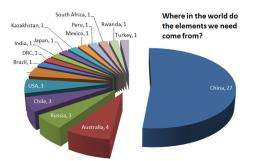Chart indicates the number of times a country is the leading global producer of an element or element group of economic, Source: BGS World Mineral Statistics, BGS©NERC
(PhysOrg.com) -- A new list published by the British Geological Survey, or BGS, ranks 52 of Earth's elements based on their risk of supply disruption. Andrew Bloodworth, from BGS, points out that the likelihood of the world running out of these elements in the near future is slim but that the risks to their supply are from humans.
Risk factors include things such as the delay between finding a resource and its extraction, accidents, geopolitics and resource nationalism. Certain countries also hold a monopoly on most of these elements. China is the home to 97 percent of all rare Earth elements and is the main country responsible for extraction of all 52 elements on the new list.
The list includes elements such as indium and niobium which are used in a variety or digital devices and antimony, the element at the top of the list, which is used for fire-proofing.
As early as 10 years ago most of these metals would have been of little interest, but the move toward creating low-carbon and renewable energy technologies require the use of these metals. Devices such as smart phones, electric cars, flat screen televisions and rechargeable batteries would not be possible.
Bloodworth hopes that this new list will open some eyes to the demand of these metals in both the public and those responsible for their use. The need to diversify their supply sources and eliminate current monopolies on them is crucial. These metals can be found in other areas including Australia, Brazil and Southern Africa and these areas need to be explored for possible extraction locations.
With millions of new phones being made each year, the demand for these metals will not be declining anytime soon. While the metals can be recycled, current placement makes recycling to energy intensive and expensive. They hope this report will show manufactures that they need to design and embed the metals so they are more accessible for recycling.
More information: Online report
© 2011 PhysOrg.com





















